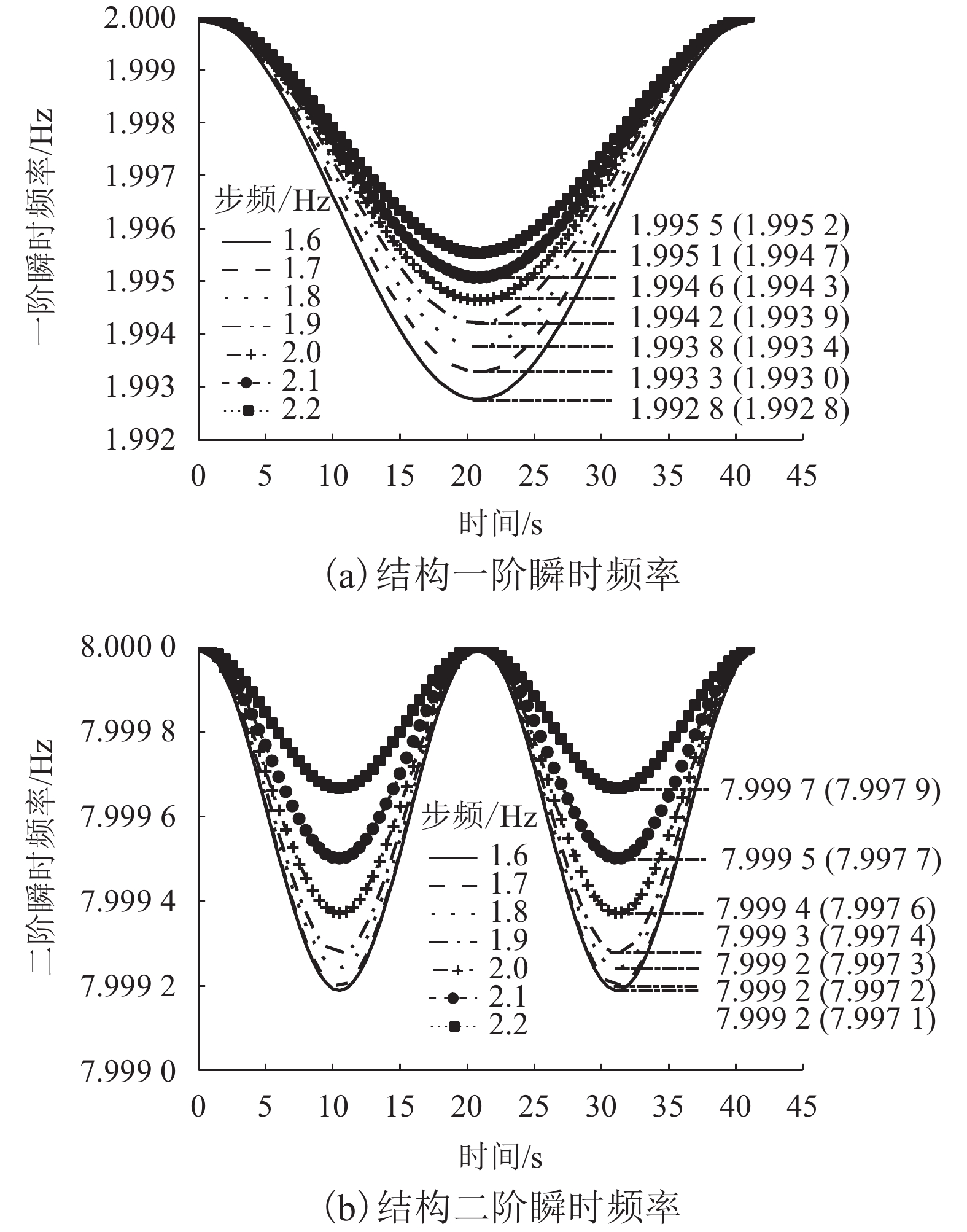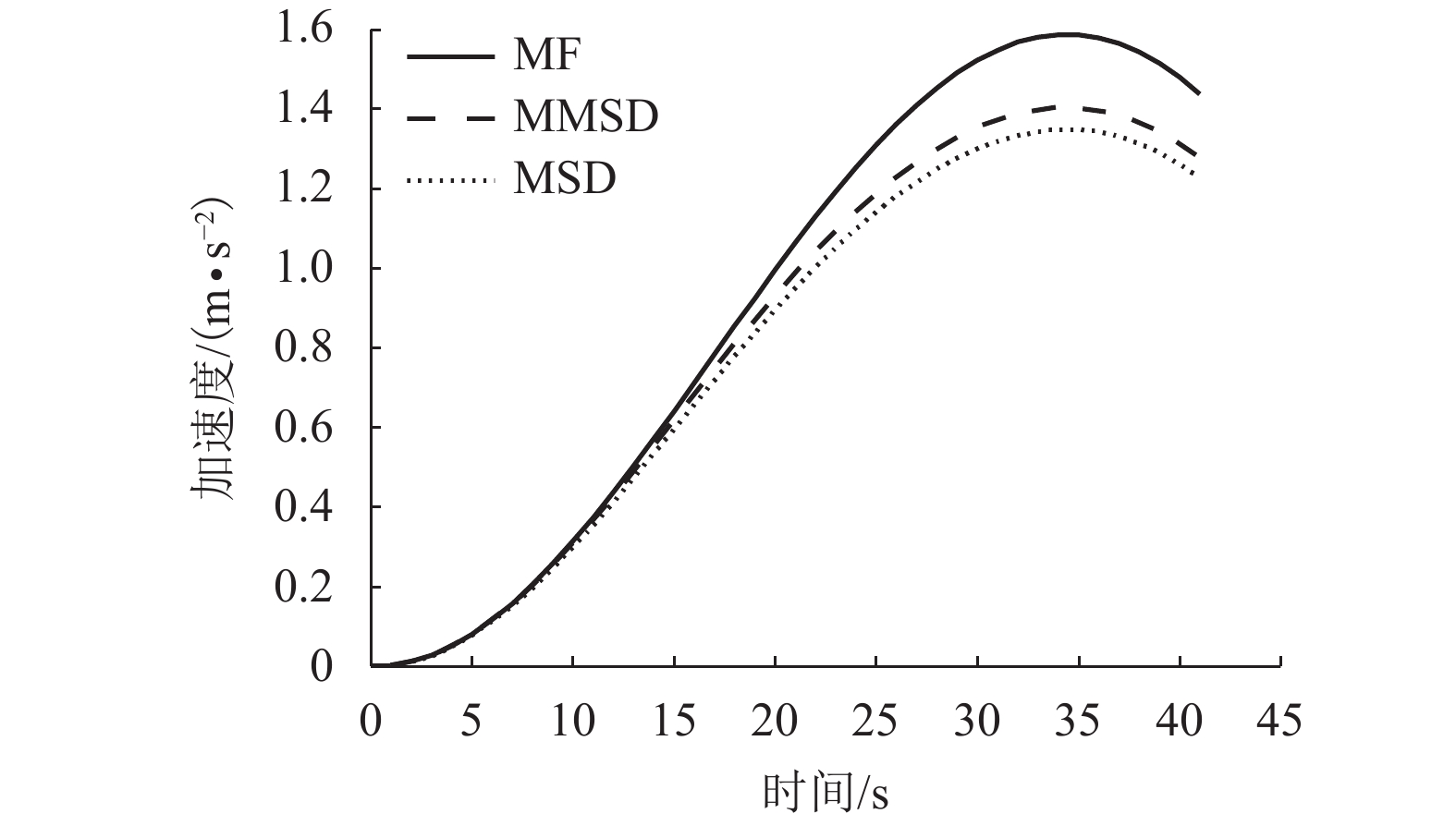Two Simplified Models for Human-Structure Vertical Interaction
-
摘要: 基于质量-刚度-阻尼(mass-spring-damper,MSD)和质量-刚度-阻尼-附加质量(mass-spring-damper-rigid mass,MMSD)两类简化分析模型,采用正则化结构振型函数建立简化的人-结构竖向相互作用动力方程. 针对具有非比例阻尼特性的动力方程,采用状态空间法求解耦合系统瞬时频率和阻尼比,讨论两种耦合动力方程的区别以及结构在人行荷载作用下频率和阻尼比的变化规律,分析人-结构耦合状态下结构加速度响应的差异. 结果表明:考虑人-结构竖向相互作用时,两类动力方程的结构阻尼比显著增大,结构瞬时频率略有减小,瞬时阻尼比峰值平均提高31.67%,瞬时频率峰值平均仅减小0.29%; 结构人致振动分析时应考虑人-结构竖向相互作用;MSD和MMSD两种模型分析情况下,结构动力响应差异很小,均方根加速度值的差异仅为0.34%.
-
关键词:
- 人-结构竖向相互作用 /
- 人致振动 /
- 模态分析 /
- 简化分析模型 /
- 振动分析
Abstract: Based on a mass-spring-damper(MSD)model and a mass-spring-damper-rigid mass(MMSD)model, which are two kinds of pedestrian simplified models, the equations of vertical dynamic interaction pertaining to a simplified human-structure were deduced by the regularization structure modal function. Using the dynamic equation with non-proportional damping characteristics, the state-space method was used to solve the instantaneous frequency and damping ratio of the system equations; the difference between the two coupled dynamic equations and the change regularity of frequency and damping ratio of the structure under walking load were discussed, and the difference in the structural acceleration response in a human-structure coupled state was analysed. The results show that the structural damping ratio between the two kinds of equations is significantly different; however, the instantaneous frequency of the structure is only slightly distinct, considering the vertical interaction between a human and a structure. The instantaneous damping ratio peak increases by an average of 31.67%, and the instantaneous frequency reduces by an average of 0.29%. Human-structure vertical interaction must be considered in response to human-induced structural vibration analysis. The difference in structural dynamic responses between the MSD and MMSD models is very small, and the difference in the root mean square acceleration is only 0.34%. -
表 1 部分研究者提出的模型参数
Table 1. Model parameters by some researchers
表 2 不同附加刚性质量下的结构加速度值
Table 2. Structural acceleration with different rigid masses
最大加速度
/(m•s–2)m0/kg 4 5 6 7 8 amax 1.631 1 1.632 2 1.633 2 1.634 3 1.635 3 {a_{\max {\text{-}} {\rm s}}} 1.976 2 1.977 0 1.977 9 1.978 7 1.979 5 -
高世桥,王栋,牛少华. 人-结构耦合系统动态特性分析[J]. 北京理工大学学报,2013,17(15): 235-238GAO Shiqiao, WANG Dong, NIU Shaohua. Analysis of dynamic characteristics of person-structure coupled system[J]. Journal of Beijing Institute of Technology, 2013, 17(15): 235-238 SHAHABPOOR E, PAVIC A, RACIC A. Iden tification of mass-spring-damper model of walking humans[J]. Structures, 2016, 5: 233-246 doi: 10.1016/j.istruc.2015.12.001 AHMADI E, CAPRANI C C, HEIDARPOUR A. An equivalent moving force model for consideration of human structure interaction[J]. Applied Mathematical Modelling, 2017, 51: 526-545 doi: 10.1016/j.apm.2017.06.042 VAN NIMMEN K, LOMBAERT G, DEROECK G, et al. The impact of vertical human-structure interaction on the response of footbridges to pedestrian excitation[J]. Journal of Sound and Vibration, 2017, 402: 104-121 doi: 10.1016/j.jsv.2017.05.017 SACHSE R. Modeling effects of human occupants on modal properties of slender structures[J]. The Structural Engineer, 2002, 80: 21-23 MATSUMOTO Y, GRIFFIN M J. Mathematical models for the apparent masses of standing subjects exposed to vertical wholebody vibration[J]. Journal of Soundand Vibration, 2003, 260(3): 431-451 doi: 10.1016/S0022-460X(02)00941-0 陈舟,颜全胜,胡俊亮,等. 人群-桥梁耦合振动研究及参数分析[J]. 华南理工大学学报(自然科学版),2014,42(5): 75-82CHEN Zhou, YAN Quansheng, HU Junliang, et al. Coupling vibration investigation and parameter analysis of crowd-bridge system[J]. Journal of South China University of Technology (Natural Science Edition), 2014, 42(5): 75-82 张梦诗,陈隽,徐若天. 竖向行人-结构相互作用中的行人MD及SMD模型参数识别[J]. 振动工程学报,2016,29(5): 814-821ZHANG Mengshi, CHEN Jun, XU Ruotian. MD and SMD model parameters of pedestrians for vertical human-structure interaction[J]. Journal of Vibration Engineering, 2016, 29(5): 814-821 MULLARNEY B, ARCHBOLD P. Modelling the vertical load a-pplied by pedestrians at a range of walking velocit-ies[J]. Australian Journal of Basic and Applied Sciences, 2013, 7(5): 266-277 王光远. 结构动力学[M]. 北京: 高等教育出版社, 2015: 284-289 刘延柱, 陈立群, 陈文良. 振动力学[M]. 北京: 高等教育出版社, 2016: 190-193 ARCHBOLD P, KEOGH J, CAPRANI C C, et al. Aparametric study of pedestrian vertical force models for dy-namic analysis of footbridges[C]//Proceedings of the EVACES Experimental Vibration Analysis for Ci-vil Engineering Structures. Dublin: Dublin Institute of Technology, 2011: 35-44 CAPRANI C C, KEOGH J, ARCHBOLD P, et al. Characteristic vertical response of a footbridge due to crowd loading[C]//Eurodyn 2011 Eigth European Conference on Structural Dynamics. Leuven: [s.n.], 2011: 978-985 SHAHABPOOR E, PAVIC A, RACIC A. Using MSD model to simulate human-structure interaction duringwal king[C]//Proceedings of the 31st IMAC, A Conference on Structural Dynamics. [S.l.]: The Society for Experimental Mechanics, 2013: 357-364 陈建英,方之楚. 人-结构相互作用动力学建模研究[J]. 振动与冲击,2007,26(6): 10-15 doi: 10.3969/j.issn.1000-3835.2007.06.003CHEN Jianying, FANG Zhichu. Study on modeling of human occupants-structure dynamic interaction[J]. Journal of Vibration and Shock, 2007, 26(6): 10-15 doi: 10.3969/j.issn.1000-3835.2007.06.003 何浩祥,闫维明,张爱林. 人行激励下梁板结构与人体耦合作用研究[J]. 振动与冲击,2008,27(10): 130-133 doi: 10.3969/j.issn.1000-3835.2008.10.031HE Haoxiang, YAN Weiming, ZHANG Ailin. Dynamic interaction between human and beam-slab structures under human walking excitation[J]. Journal of Vibration and Shock, 2008, 27(10): 130-133 doi: 10.3969/j.issn.1000-3835.2008.10.031 王海,周叮,王曙光. 人-梁相互作用动力学模型研究[J]. 工程力学,2010,27(5): 14-20WANG Hai, ZHOU Ding, WANG Shuguang. Modeling of the dynamic interaction of human occpupants and beam[J]. Engineering Mechanics, 2010, 27(5): 14-20 SILVA F T, PIMENTEL R L. Biodynamic walking model for vibration serviceability of footbridges in vertical direction[C]//Proceeding of the 8th International Conference on Structural Dynamics. Leuven: [s.n.], 2011: 1090-1096 -






 下载:
下载:







